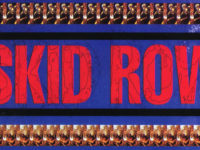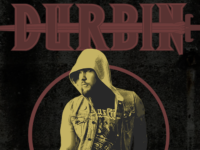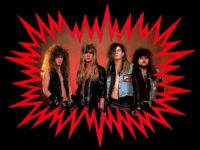A recent discussion around the water cooler at Something Else! Towers got me thinking about the development of my musical tastes. The topic was how the Internet has changed music consumption. One of the points raised was that the availability of music on the web has allowed people to sink into one musical niche and not explore outside of it. My argument was that the Internet has allowed me to discover artists that I never would have had access to before. I contrasted that with my youth, when my tastes were developing and I had limited access to music and limited money for it. I usually made damned sure before I put that money down that I was going to like a record, and I rarely made an impulse purchase.
It’s funny then that my heavy metal journey — the one that I’ve been on for close to 30 years now — started with an impulse purchase. Growing up in a small town in northern Louisiana, my options for buying music were limited. There were a few stores around town that had a small case filled with cassettes, and there was Walmart and a now-defunct regional chain called Howard Brothers. As you can imagine, there wasn’t a huge selection.
I was 11 years old, largely listening to Top 40 radio and the music that my parents listened to, and I had no idea at the time what heavy metal was, or even that it existed. I was walking through Walmart with my parents one day when a misplaced LP on the end of the music aisle caught my eye. The cover featured a guy in a red leather straightjacket and this weird metal mask, and the name of the record was Metal Health. My mother noticed it, too, and rolling her eyes, snorted at it. I found it fascinating, though, and my mind kept returning to it.
This was before “Cum on Feel the Noize” was a big hit for Quiet Riot, and I had no idea what kind of music was on the record, but I knew I had to have it. On the next trip to the store, I pulled out my lawn-mowing money ($7.96 plus tax, in those days, or about a yard and a half) and bought the cassette version despite my mother’s eye-rolling. I got home, popped it into my shoebox cassette player, and was rewarded with those first few power chords of the title track. My reaction to the sound, which wasn’t quite like anything I’d heard before, was immediate. It remains much the same 28 years later whenever I hear the song — a rising urge to do as it commands and bang my head. Admittedly, the song is terribly dated now, but every time I hear it, I still crank it up and yell along.
Next up was Quiet Riot’s biggest hit, a cover of Slade’s “Cum on Feel the Noize.” I liked it for the same reason most of the people who made it a hit liked it — it’s an incredibly catchy, fantastic rock ‘n’ roll song. I don’t remember if it was summer when this song was a hit, but I’m betting it was. It’s a great, windows-down, wind-in-the-hair song.
In the years since I got my cassette copy, they’ve reconfigured the song list, but on my version the instrumental guitar solo “Battle Axe” was third. Again, I had no experience with this kind of flashy shredding, and I thought it was absolutely amazing. It’s probably the first thing that I ever heard that made me want to pick up a guitar. As I listened to more of this kind of music, I learned that it wasn’t quite as awesome as I originally thought, but I still have a soft spot for it.
Party rocker “Slick Black Cadillac” rolled out of the tinny little speaker on that cassette player next. Though not a hit for Quiet Riot, it’s another great candidate for that big, fun mindless summer song. As an aside, I always wondered who Sonny Doyle was and what was so special about his hubcaps. It was years before I realized they were “solid gold hubcaps.” We didn’t have the lyrics printed out in the liner notes for us back in those days, kiddies, and I’ve got plenty more bonehead interpretations where that came from.
Finally, to end the A side was the ballad “Love’s a Bitch,” which had a pretty obvious appeal to an 11-year-old boy. “Oooh, he said ‘bitch.’” I still like the song, though it doesn’t have quite the impact on me these days.
The first side of the album was by far the better, but there were some great songs on the B side as well. There’s the galloping, quintessentially early 1980s rocker “Breathless,” the slamming “Run for Cover,” and the slightly dirty “Let’s Get Crazy,” which again had that appeal to an 11-year-old boy. I thought those few “dirty” lyrics were pretty clever double entendre at the time, but listening to the song a little later in life, I realized there really was no “double” involved.
The real champ of the second side, though, and many would argue of the band’s career is “Thunderbird,” singer Kevin DuBrow’s ode to guitarist Randy Rhoads, who started his career with Quiet Riot and then left for fame with Ozzy Osbourne before being killed in a plane crash in March of 1982. It opens with a piano piece, which seems a bit out of place for this record, and then rolls on into a huge, soaring gang chorus that may seem a little over the top to some, but for a guy like me, who worshipped at the altar of Randy Rhoads as a young wannabe guitar player (and as an old wannabe guitar player for that matter), it still makes the hairs on the back of my neck stand up a little.
So Metal Health was the first metal record I owned, and Quiet Riot was officially my favorite band for a few years. I had posters, shirts airbrushed with the band’s name (I had no outlet to buy official T-shirts back then) and spent about $10 to win a $2 Quiet Riot mirror at the local fair (which I still have, by the way).
I’m still a fan of their follow-up, Condition Critical, which arrived in 1984, although there did seem to be some desperation to that record. They went back to the well, covering Slade’s “Mama Weer All Crazee Now” in an attempt to recreate the success of “Cum on Feel the Noize,” and the fractures in the band were beginning to show.
By the time the poppy and commercial QRIII arrived in 1986, I had discovered Black Sabbath, rediscovered Aerosmith’s 1970s material (after unknowingly growing up listening to it riding in the car with my aunt) and was well immersed in the wider metal world. Though I tried, I couldn’t stick with them through the mess that was QRIII, and after they released the 1988 self-titled album without DuBrow, I pretty much wrote the band off until many years later.
In 1998, I finally had the chance to see the Metal Health-era lineup of the band — DuBrow, drummer Frankie Banali, bassist Rudy Sarzo and guitarist Carlos Cavazo — when they opened for Ted Nugent. I couldn’t pass it up, and when the night was over, I was glad I didn’t. I felt like a kid again and spent weeks listening to the old records.
A few years later, in 2003, I was the entertainment editor at a local paper when the band came to town to play at a club, and I had the chance to exchange emails with Banali and chat with DuBrow, which was great fun for me. In total geek style, I took a copy of the article I wrote to the gig to have them all sign it. My ears are still ringing from that show, which was in a very small club that I think the band thought was a 15,000-seat arena, judging by the volume they pumped out. DuBrow, despite the obviously bad wigs he wore in those later years, was still as flashy and animated as ever, and the band put on a hell of a show — treating the crowd of a couple hundred as though it were a crowd of 15,000 as well.
That would be my second and last opportunity to see Quiet Riot. In 2007, DuBrow was found dead in his home in Las Vegas, ending an up-and-down career that saw the band become the first metal act to score a No. 1 record and then quickly fade into obscurity. Banali put together a new version of Quiet Riot in 2010 with the blessing of DuBrow’s mother and is touring and planning to release new music. With all due respect to Frankie and Mrs. DuBrow, I just can’t muster much interest in Quiet Riot without DuBrow, Sarzo and Cavazo. Instead, I think I’ll just continue to crank Metal Health, remember those two great late-career shows I got to see and, oh yeah, bang my head.




